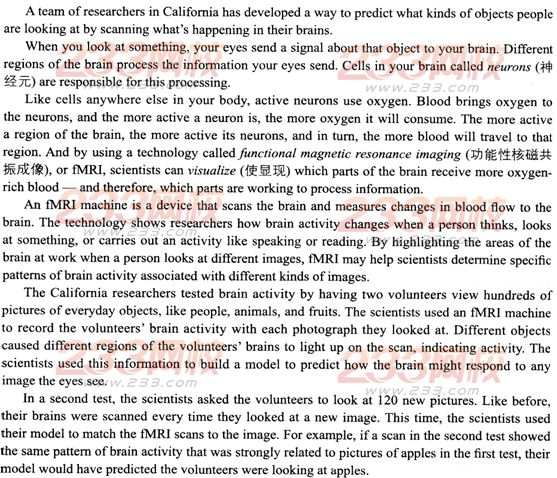2014гЂФМУПвЛ(530)
бЁ
1Questionsare based on the following passage.Sixteen years ago, Eileen Doyle's husband, an engineer, took his four children up for an early morning cup of tea, packed a small case and was never seen or heard of again. Eileen was astonished and in a state of despair. They had been a happy
family and, as far as she knew, there had been nothing wrong with their marriage.
Every day of the year, a small group of men and women quietly pack a few belongings and without so much as a note or a good-bye close the front door for the last time, leaving their debts, their worries and their confused families behind them.
Last year, more than 1,200 men and nearly as many women were reported missing from home--the highest in 15 years.
Many did return home within a year, but others rejected the past completely and are now living a new life somewhere under a different identity.
To those left behind this form of desertion is a terrible blow to their pride and self-confidence. Even the finality of death might be preferable. At least it does not imply rejection or failure. Worse than that, people can be left with an unfinished
marriage, not knowing whether they will have to wait seven years before they are free to start a fresh life.
Clinical psychologist Paul Brown believes most departures of this kind to be well planned rather than impulsive. "It's typical of the kind of personality which seems able to ignore other people's pain and difficulties. Running away, like killing
yourself, is a highly aggressive act. By creating an absence the people left behind feel guilty, upset and empty."
The Salvation Army's Investigation Department has a 70 percent success rate in tracking missing people down. According to Lt. Co. Bramwell Pratt, head of the department, men and women run away for very different reasons though lack of
communication is often the biggest motive. "The things that disturb a man's personality are problems like being tied up in debt or serious worries about work. And some women make impossible demands on their husbands. Women usually leave for more obvious reasons but fear is at the root of it. Men are more often prepared to give their marriage another try than women, but we are aware that, for some wives, it would be a total impossibility to return after the way they've been treated."
зЂтЃКЫВкДтПЈ2
When her husband left home, Eileen Doyle __
A could not forgive him for taking the children
B had been expecting it to happen for some time
C could not understand why
D blamed herself for what had happened
2аВиДтЃК

What is responsible for processing a signal sent by people's eyes?
AOxygen-rich blood.
BNeurons in the brain.
CA small region of the brain.
DThe central part of the brain.
3Nowadays a demand for this specialized type of service has been created because .
Athere is a lack of jobs available for artistic people
Bthere are so many toplevel jobs available
Cthere are so many people out of work
Dthe job history is considered to be a work of art
4

ЯЃиД

5ФЖФЃиДтЁЃ


6Facing evidence beyond any disputeshe___________ЭЕЬЈдЃ
7There are plenty of opportunities for everyone in our societybut only____________ (аЉУГзМвИпЖШГжА)can make use of them to achieve purpose
8What's the requirement of the Publicity and Education in the Prevention and Control of AIDS and STDs?

9
Moving to Survive
B) In pursuing its prey, the shark demonstrated in a dramatic way the important role of movement, or locomotion, in animals. Like the shark, most animals use movement to find food. They also use locomotion to escape enemies, find a mate, and explore new territories. The methods of locomotion include crawling, hopping, slithering, flying, swimming, or walking. Humans have the added advantage of using their various inventions to move about in just about any kind of environment. Automobiles, rockets, and submarines transport humans from deep oceans to as far away as the moon. However, for other animals movement came about naturally through millions of years of evolution. One of the most successful examples of animal locomotion is that of the shark. Its ability to quickly zero in on its prey has always impressed scientists. But it took a detailed study by Duke University marine biologists S. A. Wainwright, F. Vosburgh, and J. H. Hebrank to find out how the sharks did it. In their study the scientists observed sharks swimming in a tank at Marine land in Saint Augustine, Fla. Movies were taken of the sharks movements and analyzed. Studies were also made of shark skin and muscle.
Skin Is the Key
C) The biologists discovered that the skin of the shark is the key to the animals high efficiency in swimming through the water. The skin contains many fibers that crisscross like the inside of a belted radial tire. The fibers are called collagen fibers. These fibers can either store or release large amounts of energy depending on whether the fibers are relaxed or taut. When the fibers are stretched, energy is stored in them the way energy is stored in the string of a bow when pulled tight. When the energy is released, the fibers become relaxed.
D) The Duke University biologists have found that the greatest stretching occurs where the shark bends its body while swimming. During the bodys back and forth motion, fibers along the outside part of the bending body stretch greatly. Much potential energy is stored in the fibers. This energy is released when the sharks body snaps back the other way.
As energy is alternately stored and released on both sides of the animals body, the tail whips strongly back and forth. This whip-like action propels the animal through the water like a living bullet.
Source of Energy
E) What causes the fibers to store so much energy? In finding the answer the Duke University scientists learned that the sharks similarity to a belted radial tire doesnt stop with the skin. Just as a radial tire is inflated by pressure, so, too, is the area just under the sharks collagen radials. Instead of air pressure, however, the pressure in the shark may be due to the force of the blood pressing on the collagen fibers.
F) When the shark swims slowly, the pressure on the fibers is relatively low. The fibers are more relaxed, and the shark is able to bend its body at sharp angles. The animal swims this way when looking around for food or just swimming. However, when the shark detects an important food source, some fantastic involuntary changes take place. The pressure inside the animal may increase by 10 times. This pressure change greatly stretches the fibers, enabling much energy to be stored. This energy is then transferred to the tail, and the shark is off. The rest of the story is predictable.
Dolphin Has Speed Record
G) Another fast marine animal is the dolphin. This seagoing mammal has been clocked at speeds of 32 kilometers (20 miles) an hour. Biologists studying the dolphin have discovered that, like the shark, the animals efficient locomotion can be traced to its skin. A dolphins skin is made up in such a way that it offers very little resistance to the water flowing over it. Normally when a fish or other object moves slowly through the water, the water flows smoothly past the body. This smooth flow is known as laminar flow. However, at faster speeds the water becomes more turbulent along the moving fish. This turbulence muses friction and slows the fish down.
H) In a dolphin the skin is so flexible that it bends and yields to the waviness of the water. The waves, in effect, become tucked into the skins folds. This allows the rest of the water to move smoothly by in a laminar flow. Where other animals would be slowed by turbulent water at rapid speeds, the dolphin can race through the water at record breaking speeds.
Other Animals Less Efficient
I) Not all animals move as efficiently as sharks and dolphins. Perhaps the greatest loser in locomotion efficiency is the slug. The slug, which looks like a snail without a shell, lays down a slimy trail over which it crawls. It uses so much energy producing the slimy mucus and crawling over it that a mouse traveling the same distance uses only one twelfth as much energy. Scientists say that because of the slugs inefficient use of energy, its lifestyle must be restricted. That is, the animals are forced to confine themselves to small areas for obtaining food and finding proper living conditions. Have humans ever been faced with this kind of problem?
According to the passage, a shark can use movement to find food, to avoid being chased by its enemies, and to find a new place to live.
10My view on online promotion
1ЪНжЖ
2дДЪВУД
1Questionsare based on the following passage.Sixteen years ago, Eileen Doyle's husband, an engineer, took his four children up for an early morning cup of tea, packed a small case and was never seen or heard of again. Eileen was astonished and in a state of despair. They had been a happy
family and, as far as she knew, there had been nothing wrong with their marriage.
Every day of the year, a small group of men and women quietly pack a few belongings and without so much as a note or a good-bye close the front door for the last time, leaving their debts, their worries and their confused families behind them.
Last year, more than 1,200 men and nearly as many women were reported missing from home--the highest in 15 years.
Many did return home within a year, but others rejected the past completely and are now living a new life somewhere under a different identity.
To those left behind this form of desertion is a terrible blow to their pride and self-confidence. Even the finality of death might be preferable. At least it does not imply rejection or failure. Worse than that, people can be left with an unfinished
marriage, not knowing whether they will have to wait seven years before they are free to start a fresh life.
Clinical psychologist Paul Brown believes most departures of this kind to be well planned rather than impulsive. "It's typical of the kind of personality which seems able to ignore other people's pain and difficulties. Running away, like killing
yourself, is a highly aggressive act. By creating an absence the people left behind feel guilty, upset and empty."
The Salvation Army's Investigation Department has a 70 percent success rate in tracking missing people down. According to Lt. Co. Bramwell Pratt, head of the department, men and women run away for very different reasons though lack of
communication is often the biggest motive. "The things that disturb a man's personality are problems like being tied up in debt or serious worries about work. And some women make impossible demands on their husbands. Women usually leave for more obvious reasons but fear is at the root of it. Men are more often prepared to give their marriage another try than women, but we are aware that, for some wives, it would be a total impossibility to return after the way they've been treated."
зЂтЃКЫВкДтПЈ2
When her husband left home, Eileen Doyle __
A could not forgive him for taking the children
B had been expecting it to happen for some time
C could not understand why
D blamed herself for what had happened
2аВиДтЃК

What is responsible for processing a signal sent by people's eyes?
AOxygen-rich blood.
BNeurons in the brain.
CA small region of the brain.
DThe central part of the brain.
3Nowadays a demand for this specialized type of service has been created because .
Athere is a lack of jobs available for artistic people
Bthere are so many toplevel jobs available
Cthere are so many people out of work
Dthe job history is considered to be a work of art
4

ЯЃиД

5ФЖФЃиДтЁЃ



6Facing evidence beyond any disputeshe___________ЭЕЬЈдЃ
7There are plenty of opportunities for everyone in our societybut only____________ (аЉУГзМвИпЖШГжА)can make use of them to achieve purpose
8What's the requirement of the Publicity and Education in the Prevention and Control of AIDS and STDs?

9
Animals on the Move
A) It looked like a scene from Jaws but without the dramatic music. A huge shark was slowly swimming through the water, its tail swinging back and forth like the pendulum of a clock. Suddenly sensitive nerve ending in the sharks skin picked up vibrations of a struggling fish. The shark was immediately transformed into a deadly, efficient machine of death. With muscles taut, the shark knifed through the water at a rapid speed. In a flash the shark caught its victim, a large fish, in its powerful jaws. Then, jerking its head back and forth, the shark tore huge chunks of flesh from its victim and swallowed them. Soon the action was over.Moving to Survive
B) In pursuing its prey, the shark demonstrated in a dramatic way the important role of movement, or locomotion, in animals. Like the shark, most animals use movement to find food. They also use locomotion to escape enemies, find a mate, and explore new territories. The methods of locomotion include crawling, hopping, slithering, flying, swimming, or walking. Humans have the added advantage of using their various inventions to move about in just about any kind of environment. Automobiles, rockets, and submarines transport humans from deep oceans to as far away as the moon. However, for other animals movement came about naturally through millions of years of evolution. One of the most successful examples of animal locomotion is that of the shark. Its ability to quickly zero in on its prey has always impressed scientists. But it took a detailed study by Duke University marine biologists S. A. Wainwright, F. Vosburgh, and J. H. Hebrank to find out how the sharks did it. In their study the scientists observed sharks swimming in a tank at Marine land in Saint Augustine, Fla. Movies were taken of the sharks movements and analyzed. Studies were also made of shark skin and muscle.
Skin Is the Key
C) The biologists discovered that the skin of the shark is the key to the animals high efficiency in swimming through the water. The skin contains many fibers that crisscross like the inside of a belted radial tire. The fibers are called collagen fibers. These fibers can either store or release large amounts of energy depending on whether the fibers are relaxed or taut. When the fibers are stretched, energy is stored in them the way energy is stored in the string of a bow when pulled tight. When the energy is released, the fibers become relaxed.
D) The Duke University biologists have found that the greatest stretching occurs where the shark bends its body while swimming. During the bodys back and forth motion, fibers along the outside part of the bending body stretch greatly. Much potential energy is stored in the fibers. This energy is released when the sharks body snaps back the other way.
As energy is alternately stored and released on both sides of the animals body, the tail whips strongly back and forth. This whip-like action propels the animal through the water like a living bullet.
Source of Energy
E) What causes the fibers to store so much energy? In finding the answer the Duke University scientists learned that the sharks similarity to a belted radial tire doesnt stop with the skin. Just as a radial tire is inflated by pressure, so, too, is the area just under the sharks collagen radials. Instead of air pressure, however, the pressure in the shark may be due to the force of the blood pressing on the collagen fibers.
F) When the shark swims slowly, the pressure on the fibers is relatively low. The fibers are more relaxed, and the shark is able to bend its body at sharp angles. The animal swims this way when looking around for food or just swimming. However, when the shark detects an important food source, some fantastic involuntary changes take place. The pressure inside the animal may increase by 10 times. This pressure change greatly stretches the fibers, enabling much energy to be stored. This energy is then transferred to the tail, and the shark is off. The rest of the story is predictable.
Dolphin Has Speed Record
G) Another fast marine animal is the dolphin. This seagoing mammal has been clocked at speeds of 32 kilometers (20 miles) an hour. Biologists studying the dolphin have discovered that, like the shark, the animals efficient locomotion can be traced to its skin. A dolphins skin is made up in such a way that it offers very little resistance to the water flowing over it. Normally when a fish or other object moves slowly through the water, the water flows smoothly past the body. This smooth flow is known as laminar flow. However, at faster speeds the water becomes more turbulent along the moving fish. This turbulence muses friction and slows the fish down.
H) In a dolphin the skin is so flexible that it bends and yields to the waviness of the water. The waves, in effect, become tucked into the skins folds. This allows the rest of the water to move smoothly by in a laminar flow. Where other animals would be slowed by turbulent water at rapid speeds, the dolphin can race through the water at record breaking speeds.
Other Animals Less Efficient
I) Not all animals move as efficiently as sharks and dolphins. Perhaps the greatest loser in locomotion efficiency is the slug. The slug, which looks like a snail without a shell, lays down a slimy trail over which it crawls. It uses so much energy producing the slimy mucus and crawling over it that a mouse traveling the same distance uses only one twelfth as much energy. Scientists say that because of the slugs inefficient use of energy, its lifestyle must be restricted. That is, the animals are forced to confine themselves to small areas for obtaining food and finding proper living conditions. Have humans ever been faced with this kind of problem?
According to the passage, a shark can use movement to find food, to avoid being chased by its enemies, and to find a new place to live.
10My view on online promotion
1ЪНжЖ
2дДЪВУД
ЮГ
| ПЮГЬзЈвЕУћГЦ | НВЪІ | дМл/гХЛнМл | УтЗбЬхбщ | БЈУћ |
|---|---|---|---|---|
| ЁЖДѓбЇгЂгяЫФМЖЁЗОЋЦЗАрЃЈАќРЈгяЗЈЁЂДЪЛуЁЂЗвыЃЉ | ЖЁбЉУї | ЃЄ100 / ЃЄ100 |  |
БЈУћ |
| ЁЖДѓбЇгЂгяЫФМЖЁЗОЋЦЗАрЃЈдФЖСРэНтЃЉ | ЖЁбЉУї | ЃЄ100 / ЃЄ100 |  |
БЈУћ |
| ЁЖДѓбЇгЂгяЫФМЖЁЗОЋЦЗАрЃЈЬ§СІЃЉ | ЖЁбЉУї | ЃЄ100 / ЃЄ100 |  |
БЈУћ |
| ЁЖДѓбЇгЂгяЫФМЖЁЗОЋЦЗАрЃЈаДзїЃЉ | ЖЁбЉУї | ЃЄ100 / ЃЄ100 |  |
БЈУћ |
ШЕзЈ







